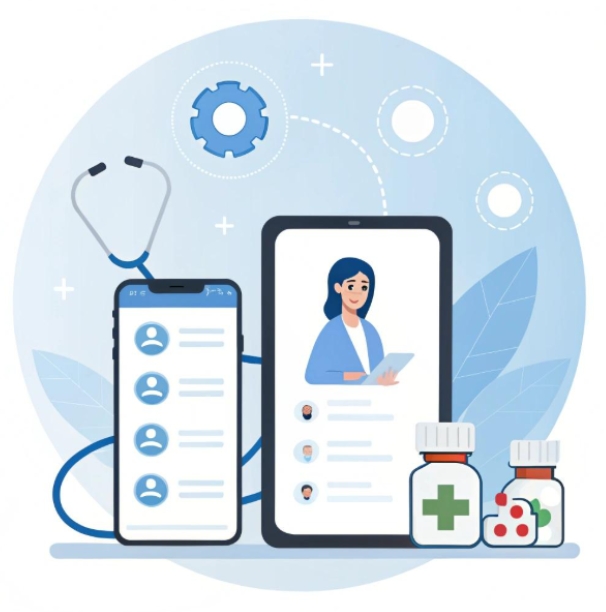Business Solutions
The Future of Healthcare SMS and RCS Messaging
Discover how Healthcare SMS and RCS messaging are transforming patient communication. Explore their evolution, current impact, and potential to reshape healthcare interactions.
Published
1 hour agoon
By
Marks Strand
Why Messaging Still Matters in Healthcare
In an age of apps, portals, and wearable health tech, it’s easy to underestimate the power of a simple message. But healthcare SMS remains one of the most reliable and widely used tools for engaging patients. Combined with emerging technologies like an RCS API, messaging is evolving into a powerful ecosystem of interactive, secure, and branded communications that connect providers and patients with speed and clarity.
Healthcare runs on communication—appointment reminders, prescription updates, lab result alerts, and care follow-ups. When every second matters, especially in time-sensitive situations, SMS delivers unmatched immediacy. And now, richer formats powered by RCS are pushing the boundaries of what’s possible with mobile messaging.
What Is Healthcare SMS and How Is It Used?
Healthcare SMS refers to the use of standard text messages for medical communication. This includes sending appointment confirmations, pre-visit instructions, vaccine reminders, billing alerts, or test result notifications directly to a patient’s mobile phone.
It’s effective because it meets patients where they are—on their phones. SMS messages have open rates above 90%, and most are read within three minutes of delivery. That makes SMS ideal for quick, actionable healthcare updates, especially for patients who may not check emails or download apps.
For clinics and hospitals, SMS reduces no-shows, streamlines intake, and improves patient satisfaction by making communication simple and accessible.
Introduction to RCS API: Richer Messaging Explained
RCS, or Rich Communication Services, is an upgrade to SMS that transforms basic messages into dynamic, app-like experiences. An RCS API allows healthcare organizations to integrate rich content—like buttons, carousels, images, maps, and branded headers—into their messaging flows.
Instead of sending plain-text appointment reminders, for example, providers can send messages that let patients confirm or reschedule with one tap. RCS supports branding and sender verification, which builds trust and reinforces credibility. It also supports secure media attachments like PDFs and instructional videos, all within the default messaging app.
For patients, it feels like an app experience—without the hassle of downloads or sign-ins. For healthcare providers, it means higher engagement and reduced friction in patient interactions.

RCS vs SMS in Healthcare Messaging
While SMS is great for simplicity and reach, RCS brings a level of interaction and polish that today’s mobile users have come to expect. Think of the difference between a one-line reminder text and a branded message that lets you see appointment details, confirm attendance, and even get directions—all without leaving the conversation.
RCS messages can include structured formats with call-to-action buttons, image carousels for education, and secure file downloads for forms or pre-visit paperwork. Sender verification also helps prevent spoofing, which has become a growing concern in SMS-based phishing attacks.
Despite its sophistication, RCS isn’t a full replacement for SMS just yet. Not all devices or carriers support RCS, which is why fallback compatibility remains essential. A good messaging strategy uses an RCS API when supported and defaults to SMS when it’s not.
Personalization, Trust, and Patient Experience
In healthcare, trust is everything. Patients want to feel like their provider knows them, respects their time, and protects their data. Personalized messaging—using names, appointment types, and relevant context—creates a more human connection.
With RCS, personalization can go even further. Branded messaging with verified icons, tailored content, and interactive options shows professionalism and care. It reduces confusion and encourages faster action.
Moreover, mobile messaging is inherently less invasive than phone calls and more convenient than emails. When done well, it becomes a channel patients value—not avoid.
HIPAA, Privacy, and Compliance Considerations
Messaging in healthcare isn’t just about engagement—it’s also about compliance. SMS, while widely used, must be deployed in a way that aligns with HIPAA and other privacy regulations. That means limiting personal health information in plain-text messages and using opt-in workflows to ensure consent.
RCS brings new privacy advantages. Messages are sent via secure networks, with encryption during transmission. An RCS API also enables delivery acknowledgments and read receipts, helping providers confirm message status.
Still, no system is foolproof. Healthcare providers must ensure their messaging vendors follow rigorous security protocols and offer features like tokenized content, consent management, and secure fallback strategies.
Integrating RCS API into Healthcare Systems
For IT teams, the idea of adding another communication channel can feel daunting. Fortunately, most leading healthcare CRMs and messaging platforms now support API integration, allowing RCS features to be added with minimal disruption.
An RCS API typically connects with existing patient engagement tools, pulling in real-time data like appointments, referrals, or billing triggers. Messages are dynamically generated and sent to supported devices. For patients on older devices or unsupported networks, the same content can be sent via SMS, ensuring no one is left out.
It’s important to choose a messaging provider with healthcare experience. They’ll help with carrier alignment, fallback configuration, data privacy controls, and compliance certifications that meet your organization’s standards.
Limitations and Challenges with RCS in Healthcare
Despite the advantages, RCS still faces some challenges. The biggest is inconsistent support across carriers and devices. While Android adoption is growing, iPhones do not yet support RCS, which limits reach.
Fallback to SMS is essential, but it means designing content that works well in both formats. Some message features—like carousels or tap-to-confirm buttons—won’t translate to SMS, so alternatives need to be in place.
There’s also the issue of delivery monitoring. SMS systems offer delivery reports, but RCS provides more advanced analytics like read receipts, click tracking, and interaction flow data. Balancing both types of insights requires thoughtful implementation.
Engagement and Automation in Patient Messaging
Automation is a natural next step. With AI-driven chatbots and rules-based triggers, both SMS and RCS messages can be sent automatically based on patient behavior or system events.
For example, a missed appointment can trigger a follow-up message with a reschedule button. A discharged patient can receive follow-up instructions and a satisfaction survey link via RCS. A billing system can automatically send payment reminders on a schedule.
Two-way messaging also enables patients to respond, confirm, or ask questions without needing to call a clinic. This reduces staff burden and empowers patients to take more control over their care journey.
The Future of Healthcare Messaging
Looking ahead, messaging in healthcare is going to get smarter, more secure, and more integrated. We’re already seeing movement toward AI-powered triage tools, where patients can describe symptoms via RCS and receive guided next steps instantly.
Expect deeper integration with electronic health records (EHRs), allowing personalized outreach that reflects real-time clinical events. RCS messaging may also tie into wearable health devices, surfacing alerts when vitals fall outside normal ranges.
Even voice assistants may enter the mix, initiating follow-ups or reminders based on spoken queries or health calendar events. As the lines between messaging, apps, and virtual care blur, healthcare SMS and the RCS API will remain foundational to timely, trusted communication.
FAQs: Healthcare SMS and RCS Messaging
1. What is the difference between healthcare SMS and RCS messaging?
Healthcare SMS refers to traditional text messages used in medical communication, while RCS messaging enables richer content like images, buttons, and branding through supported messaging apps.
2. How does an RCS API improve patient communication?
An RCS API allows healthcare systems to send interactive, app-like messages that can include appointment confirmations, reminders, forms, and branded visuals, improving engagement and usability.
3. Is SMS still relevant with the rise of apps and portals?
Yes, SMS remains highly effective due to its universal compatibility, high open rates, and real-time delivery, especially for time-sensitive healthcare notifications.
4. Do patients need to download anything to receive RCS messages?
No. RCS works through a device’s native messaging app on supported Android phones. There’s no need for a separate app download, though fallback to SMS is used when RCS isn’t available.
5. Can RCS messaging be used for appointment scheduling?
Absolutely. RCS messages can include confirm/cancel buttons, reschedule links, and dynamic scheduling options, all directly accessible from the message itself.
6. Is it possible to personalize healthcare SMS and RCS messages?
Yes. Both SMS and RCS messages can be personalized with patient names, appointment types, and context-specific details pulled from healthcare databases or CRMs.
7. What security measures protect healthcare SMS and RCS messaging?
Security includes encrypted delivery, sender verification, short message expiration, and integration with HIPAA-compliant messaging platforms to protect sensitive patient data.
You may like
Business Solutions
Why Automotive Intrusion Detection Systems are Critical for the Future of Mobility
As vehicles become increasingly connected and autonomous, the need for robust cybersecurity measures has never been greater. Automotive Intrusion Detection Systems play a pivotal role in safeguarding modern vehicles from cyber threats. These systems monitor and detect suspicious activity within a vehicle’s network, protecting critical data and ensuring driver safety. By addressing vulnerabilities and preventing potential hacking attempts, Automotive Intrusion Detection Systems are not only a defense mechanism but a vital component in the evolution of secure and reliable mobility solutions for the future.
Published
24 hours agoon
May 14, 2025By
Adva
The modern automobile is no longer a purely mechanical marvel; it’s a sophisticated network of interconnected electronic control units (ECUs), sensors, and communication systems. This digital transformation has ushered in an era of unprecedented convenience, safety features, and infotainment options. However, it has also opened a new frontier for potential threats: cyberattacks. Just as our personal computers and networks require protection, so too do our vehicles. This is where Automotive Intrusion Detection Systems (A-IDS) step in, acting as silent guardians that are increasingly vital for the safety and security of the future of mobility.
The Evolving Threat Landscape for Connected Vehicles
The attack surface of a modern vehicle is vast and growing. Threats can originate from various sources:
External Connectivity: Bluetooth, Wi-Fi, cellular networks, and even USB ports can be exploited to gain unauthorized access.
Over-the-Air (OTA) Updates: While convenient, the software update process can be a target for malicious actors to inject harmful code.
In-Vehicle Networks: Communication protocols like CAN bus cyber security systems, Ethernet, and FlexRay, while designed for efficiency, can be vulnerable to manipulation if access is gained.
Telematics and Infotainment Systems: These connected systems often have direct or indirect pathways to more critical vehicle functions.
Physical Access: While less common, physical tampering with vehicle components can also lead to security breaches.
The consequences of a successful cyberattack on a vehicle can range from minor annoyances, like disabling the infotainment system, to catastrophic scenarios involving the manipulation of safety-critical functions like braking, steering, and acceleration. Data theft, privacy breaches, and even the use of vehicles for malicious purposes are also serious concerns.
What are Automotive Intrusion Detection Systems (A-IDS)?
A-IDS are proactive security systems designed to monitor network traffic and system behavior within a vehicle in real-time. They act as a digital sentry, constantly looking for suspicious activities or patterns that could indicate a cyber intrusion or an anomaly. When a potential threat is detected, the A-IDS can trigger alerts, log the event, and in some cases, even initiate automated responses to mitigate the risk.
Think of an A-IDS like a home security system for your car. It doesn’t prevent someone from trying to break in, but it detects their attempts and alerts you (and potentially the authorities) so you can take action.

Why are A-IDS Absolutely Crucial for Modern Vehicles?
The importance of A-IDS in the automotive industry cannot be overstated. Here’s why they are becoming increasingly critical:
Early Threat Detection: A-IDS provide a crucial layer of defense by identifying malicious activities in their early stages, allowing for timely intervention before significant damage can occur. This proactive approach is far more effective than reacting to a breach after it has already compromised vehicle systems.
Real-time Monitoring and Analysis: Unlike static security measures, A-IDS continuously monitor network traffic, system logs, and ECU behavior, providing a dynamic view of the vehicle’s security posture. This real-time analysis is essential for detecting sophisticated and evolving cyber threats.
Anomaly Detection: A-IDS can identify deviations from normal operating patterns, which could indicate a cyberattack or even a malfunctioning component. This capability is particularly important for detecting novel or zero-day exploits that haven’t been seen before.
Forensic Analysis: When a security incident does occur, A-IDS provide valuable logs and data that can be used for forensic analysis, helping to understand the attack vector, the extent of the compromise, and how to prevent future incidents.
Enabling Security by Design: Integrating A-IDS early in the vehicle development process allows manufacturers to build a more resilient and secure architecture. The insights gained from A-IDS can inform the design of future vehicle systems.
Meeting Regulatory Requirements: As awareness of automotive cybersecurity risks grows, regulatory bodies are increasingly mandating security measures like A-IDS. Compliance with standards like ISO 21434 often necessitates the implementation of robust intrusion detection capabilities.
Protecting Safety-Critical Systems: The most critical function of A-IDS is to safeguard safety-related systems from malicious manipulation. Detecting and preventing attacks on braking, steering, or airbag deployment systems is paramount for ensuring the safety of drivers and passengers.
Building Consumer Trust: In an era of increasing connectivity, consumers are rightly concerned about the security of their vehicles and their personal data. Implementing and highlighting the presence of A-IDS can build trust and confidence in a manufacturer’s commitment to cybersecurity.
Challenges and Considerations for Implementing A-IDS
Implementing effective A-IDS in vehicles presents unique challenges:
Resource Constraints: Automotive ECUs often have limited processing power and memory, requiring A-IDS to be highly efficient and lightweight.
Real-time Performance: Security monitoring must not interfere with the real-time operation of critical vehicle functions.
Complexity of Vehicle Networks: The intricate and diverse nature of in-vehicle networks requires A-IDS to be adaptable and capable of understanding various communication protocols.
False Positives: A-IDS need to be carefully tuned to minimize false alarms, which can lead to driver distraction or security alert fatigue.
Evolving Threat Landscape: A-IDS must be continuously updated with the latest threat intelligence to remain effective against new and emerging attacks.
The Future of A-IDS in Automotive Cybersecurity
As vehicles become even more connected and autonomous, the role of A-IDS will only become more critical. Future trends in A-IDS development include:
Machine Learning and AI: Leveraging AI and machine learning algorithms to improve the accuracy and effectiveness of anomaly detection and threat prediction.
Behavioral Analysis: Moving beyond signature-based detection to analyze the behavior of individual Electronic control units and network nodes to identify malicious activity.
Integration with Security Information and Event Management (SIEM): Connecting in-vehicle A-IDS with broader security monitoring systems for a holistic view of the automotive ecosystem.
Standardization and Collaboration: Increased collaboration across the automotive industry to develop common standards and best practices for A-IDS implementation.
Conclusion: Embracing the Digital Shield
Automotive Intrusion Detection Systems are no longer a luxury but a fundamental necessity for ensuring the safety, security, and trustworthiness of modern vehicles. As the automotive industry continues its rapid digital transformation, A-IDS will serve as the silent guardians, constantly monitoring and protecting our vehicles from the ever-evolving landscape of cyber threats. By embracing and investing in robust A-IDS, automotive manufacturers can pave the way for a safer and more secure future of mobility for everyone.
Business Solutions
Why High-End Real Estate Agency Services are Essential for Discerning Clients
For discerning clients seeking more than just a transaction, a High-End Real Estate Agency offers unparalleled expertise, exclusive access to luxurious properties, and deeply personalized service. These premium agencies don’t just find homes; they leverage market insights and tailored strategies to secure the most exceptional real estate opportunities, ensuring every detail aligns with your unique lifestyle and expectations.
Published
2 days agoon
May 13, 2025By
Adva
In the realm of luxury real estate, buying or selling a property transcends mere transactions. It’s about acquiring a lifestyle, securing a legacy, and navigating a complex market with expertise and discretion. This is where high-end real estate agencies step in, offering a level of service and access that goes far beyond the capabilities of traditional firms. For discerning clients seeking exceptional properties and a seamless experience, engaging a specialized high-end agency isn’t just a preference – it’s a necessity.
The Distinction: More Than Just Price Tags
High-end real estate agencies cater to a unique clientele with specific needs and expectations. They understand that luxury isn’t solely defined by price; it encompasses exceptional locations, architectural significance, premium finishes, unparalleled amenities, and, crucially, a level of service that reflects the value of the properties they represent.
Here’s why their services are indispensable for those operating in the upper echelons of the property market:
1. Access to Exclusive and Off-Market Listings:
One of the most significant advantages of working with a high-end agency is access to a curated portfolio of exclusive and often off-market properties. These hidden gems, frequently not advertised publicly, can include coveted penthouses, private estates, architecturally significant homes, and rarely available properties in prime locations. Their established networks and reputation often grant them access to these listings before they reach the broader market, providing clients with a significant advantage.
2. Bespoke and Personalized Service:
Luxury clients demand and deserve a level of service that is highly personalized and attentive. High-end agencies understand this implicitly. They assign dedicated agents who take the time to understand the client’s unique needs, preferences, and lifestyle. This bespoke approach extends to tailored property searches, private and discreet viewings, flexible scheduling, and proactive communication, ensuring a seamless and stress-free experience.
3. Unparalleled Market Expertise and Insights:
Navigating the high-end real estate market requires in-depth knowledge and a keen understanding of its nuances. Agents specializing in this sector possess a profound awareness of market trends, property values in exclusive neighborhoods, investment opportunities, and potential challenges. They can provide insightful advice, helping clients make informed decisions based on accurate and up-to-date information.
4. Discretion and Confidentiality:
Transactions involving high-value properties often involve prominent individuals who prioritize privacy. High-end agencies operate with the utmost discretion and confidentiality, safeguarding their clients’ identities and ensuring sensitive information remains protected throughout the entire process. This level of trust is paramount in the luxury market.
5. Extensive Network and Connections:
These agencies cultivate extensive networks that extend beyond just buyers and sellers. They often have strong relationships with legal professionals, financial institutions, interior designers, architects, contractors, and other premium service providers. This network can be invaluable in facilitating a smooth transaction and providing clients with access to trusted resources.
6. Sophisticated Marketing and Presentation:
Selling a luxury property requires a marketing approach that goes beyond traditional listings. High-end agencies employ sophisticated strategies, including professional photography and videography, virtual tours, high-quality brochures, targeted digital campaigns, and exclusive showings, to showcase properties to the right audience and highlight their unique features and value.
7. Negotiation Expertise at the Highest Level:
Negotiating the sale or purchase of a high-value property requires a unique skillset and a deep understanding of the complexities involved. Experienced agents from high-end agencies are adept at navigating these negotiations, advocating for their clients’ best interests while ensuring a successful and mutually agreeable outcome.
8. Comprehensive Support Beyond the Transaction:
The services of a high-end agency often extend beyond the closing of a deal. They can assist with property management, relocation services, connecting clients with local resources, and ensuring a smooth transition into their new home or the efficient management of their investment.

Why You Need Them:
For those operating in the luxury real estate market, engaging a high-end agency isn’t a luxury – it’s a strategic necessity:
Time Efficiency: Their expertise and network save clients valuable time by curating relevant properties and streamlining the entire process.
Reduced Stress: Their personalized service and proactive approach minimize the stress and complexities often associated with high-value transactions.
Maximized Value: Their market knowledge and negotiation skills help clients achieve the best possible price, whether buying or selling.
Access to Exclusive Opportunities: They unlock doors to properties and opportunities that might otherwise remain inaccessible.
Peace of Mind: Their professionalism, discretion, and comprehensive support provide clients with peace of mind throughout the entire journey.
In the rarefied world of high-end real estate, expertise, access, and unwavering service are paramount. High-end real estate agencies are the gatekeepers to this exclusive market, providing discerning clients with the specialized knowledge, personalized attention, and extensive network necessary to navigate complex transactions and secure their dream properties. Investing in their services is an investment in a seamless, successful, and ultimately rewarding real estate experience.
Business Solutions
Geneo Glam: Skin Firming Treatment for Radiant, Youthful Skin
Geneo Glam is the ultimate skin firming treatment designed to restore elasticity, enhance radiance, and leave you with a glowing, youthful complexion.
Published
6 days agoon
May 9, 2025By
Marks Strand
The Geneo Glam skin firming treatment is a luxurious, non-invasive facial that revitalizes the skin by improving firmness, elasticity, and hydration. Using advanced OxyPod technology, this treatment delivers a unique combination of exfoliation, oxygenation, and infusion of active ingredients to help the skin look smoother, tighter, and more radiant.
Key Benefits
- Firms and Hydrates
The treatment boosts collagen and elastin production, helping skin feel firmer and more supple. - Improves Elasticity
Increases the skin’s resilience and reduces the appearance of fine lines and wrinkles. - Prevents Collagen Breakdown
Helps preserve the skin’s youthful structure by protecting existing collagen and supporting healthy cell function.
Powerful Natural Ingredients
- 24K Gold Particles
Stimulate collagen production, protect skin fibers, and encourage cell renewal for a firmer, lifted appearance. - Silk Amino Acids
Strengthen the skin barrier, lock in moisture, and support collagen synthesis to reduce visible signs of aging. - Carnosine Peptides
Help protect the skin from sugar-related damage (glycation), delay cellular aging, and extend the life of skin cells. - Copper
An antioxidant and anti-inflammatory that supports collagen development, smooths fine lines, and helps with skin regeneration.
How the Treatment Works
- Exfoliation and Oxygenation
The Geneo Glam OxyPod is activated with a Primer Gel, gently exfoliating the skin and triggering a natural oxygenation process that increases blood flow and enhances skin vitality. - Infusion of Actives
Active ingredients such as gold particles, peptides, and amino acids are infused deep into the skin to firm and rejuvenate. - Hydration and Nourishment
A final serum containing hyaluronic acid, rosehip oil, and marula oil hydrates and soothes the skin, leaving it soft and glowing.
Who Should Try Geneo Glam?
This treatment is ideal for people who want to:
- Reduce fine lines and early signs of aging
- Firm and tighten sagging skin
- Restore hydration and improve skin tone
Geneo Glam offers a refreshing way to firm, lift, and hydrate your skin—leaving you with a youthful glow and smooth, resilient skin. It’s a perfect solution for anyone seeking visible results without invasive procedures or downtime.

The Future of Healthcare SMS and RCS Messaging

Why Automotive Intrusion Detection Systems are Critical for the Future of Mobility

Why High-End Real Estate Agency Services are Essential for Discerning Clients
Trending
-
Marketing & Analytics2 years ago
A Complete Guide To HubSpot’s New B2B Marketing, Sales Hub, and Prospecting Tool
-
3D Technology2 years ago
3D Scanner Technology for Android Phones: Unleashing New Possibilities
-
Marketing & Analytics2 years ago
How SMS Services And Software For Bulk SMS Sending Can Help Your Business Grow
-
3D Technology2 years ago
Mobile 3D Scanners: Revolutionizing 3D Scanning Technology
-
3D Technology3 years ago
3D scanning technologies and scanning process
-
Business Solutions1 year ago
Understanding A2P Messaging and the Bulk SMS Business Landscape
-

 Business Solutions1 year ago
Business Solutions1 year agoThe Power of Smarts SMS and Single Platform Chat Messaging
-

 Automotive2 years ago
Automotive2 years agoDSRC vs. CV2X: A Comprehensive Comparison of V2X Communication Technologies




